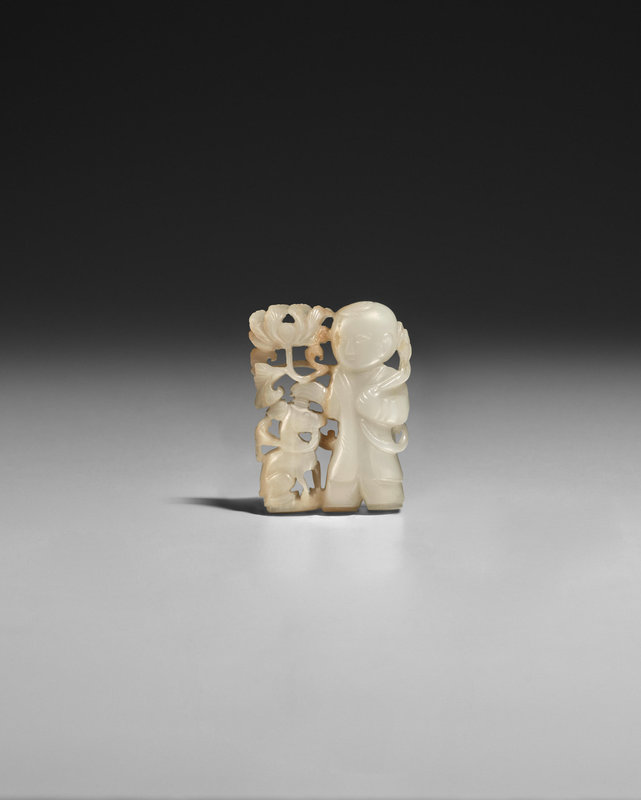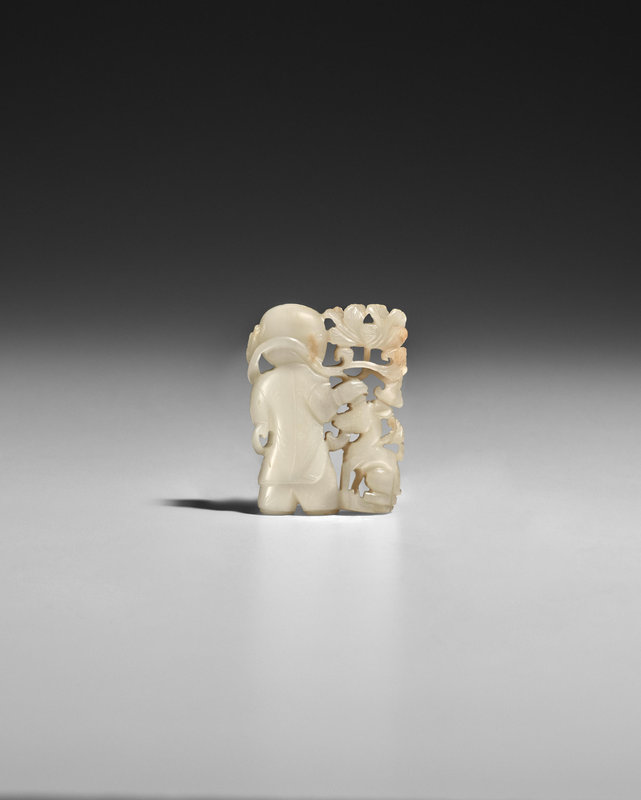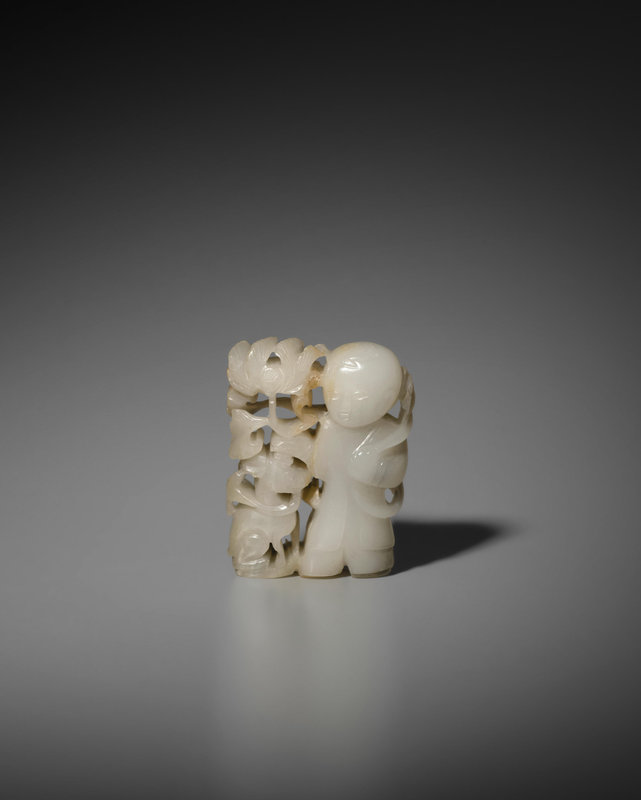A white jade openwork 'boy' pendant, Song-Ming dynasty
Lot 44. A white jade openwork 'boy' pendant, Song-Ming dynasty; 4.1cm high. Sold for US$94,875 (Estimate US$18,000 - 25,000). © Bonhams 2001-2023
Toddler with a flat peach-shaped hair bun wearing a long jacket over a pair of loose trousers, his right hand petting the small deer holding a lingzhi fungus in its mouth, the long leafy stem in his left hand going around his shoulders and ending with a large peony blossom by his head, the translucent white stone with natural russet inclusions at the center, drilled with a vertical channel for stringing.
Provenance: From the Collection of Chung Wah-pui, Hong Kong
Sotheby's Hong Kong, 8 April 2010, lot 2009.
Published: Jades from the Hei-Chi Collection, Beijing, 2006, p. 148
Note: The iconography of boy holding a large lotus blossom was very popular in the Song, Yuan and Ming dynasties, representing the wish for many sons. The small deer included in the carving also symbolizes fertility. In ancient Buddhist myth, a doe bore five hundred beautiful sons from lotus for the King. As Buddhism evolved in China, the imagery of deer with boy and lotus appeared in large numbers in jade carvings, expressing well wishes for "lian sheng gui zi" (連[蓮]生貴子, bearing sons after sons).
It is rare that the boy in the present example is holding a large peony blossom - a flower representing happiness and prosperity. Song dynasty literati Zhou Dunyi also acknowledged in his poem On the Love for Lotus that peony has been people's favorite since the Tang dynasty.
A small Yuan dynasty white jade carving of a boy with a large lotus blossom on the back of his head, discovered from the Xilin pagoda in Songjiang district, Shanghai, is illustrated in Jade wares of the Tang, Song, Yuan, Ming, Qing Unearthed from Shanghai, Shanghai, 2001, p. 37, no. 21, where the author compares characteristics between Song and Yuan jade carvings: in the Song, the large flower is placed next to or on top of the head, as opposed to in the Yuan and Ming it is placed on the back of the head or positioned lower on the boy's back; the peach-shaped hair bun with finely incised lines and the stylized ears carved in "reduced ground" (減地) technique are also typical of the Song, whereas the more pronounced hair bun and wedged ears are characteristics of the Yuan and Ming.
Another Song dynasty white jade carving of a boy holding a lotus on top of his head, in the Qing Court collection at the Palace Museum, Beijing, is illustrated on the museum's website, noted by the author that the iconography first appeared in the Tang.
Compare also the jade carving of a doe holding a lingzhi fungus in her mouth, standing on a lotus base with its fawn, in the collection of the National Palace Museum, Taipei, illustrated by Teng (ed.), Jingtian gewu: Zhongguo lidai yuqi daodu, Taipei, 2011, p. 122, no. 6-5-7, attributed by the author as Song dynasty and noting the ancient Buddhist myth of doe bearing many sons.
This white jade 'boy' pendant may have been part of the Qixi celebration on the seventh day of the seventh month on the lunar calendar, when the constellations of the cowherd and the weaving maid reunited in the sky. Recorded in the 1127 publication by Meng Yuanlao, Dongjing menghua lu (Dream of Splendor in the Eastern Capital), small figurines called Mo he le were available for purchase, mostly made of molded clay but luxury materials such as ivory, gemstone, or gold were also used. For an abstract of this Song dynasty festival together with a jade carving of the 'boy with lotus', see Watt, Chinese Jades from Han to Ch'ing, Asia Society, New York, 1980, pp. 110-111, no. 94.
Bonhams. J. J. Lally & Co. Fine Chinese Works of Art, New York, March 20, 2023

/https%3A%2F%2Fprofilepics.canalblog.com%2Fprofilepics%2F1%2F0%2F100183.jpg)
/https%3A%2F%2Fstorage.canalblog.com%2F03%2F02%2F119589%2F96711876_o.jpg)
/https%3A%2F%2Fstorage.canalblog.com%2F11%2F31%2F119589%2F94773502_o.jpg)
/https%3A%2F%2Fstorage.canalblog.com%2F20%2F83%2F119589%2F94772815_o.jpg)
/https%3A%2F%2Fstorage.canalblog.com%2F26%2F72%2F119589%2F75604929_o.jpg)
/https%3A%2F%2Fstorage.canalblog.com%2F59%2F60%2F119589%2F26458628_o.jpg)






/image%2F1371349%2F20240406%2Fob_a54acc_435229368-1644755382961141-18285727260.jpg)
/image%2F1371349%2F20240229%2Fob_b1ea4c_429582962-1625285201574826-43586635599.jpg)
/image%2F1371349%2F20240229%2Fob_84bc3b_429558450-1624783464958333-37673404077.jpg)
/http%3A%2F%2Fstorage.canalblog.com%2F36%2F88%2F119589%2F129555285_o.jpg)